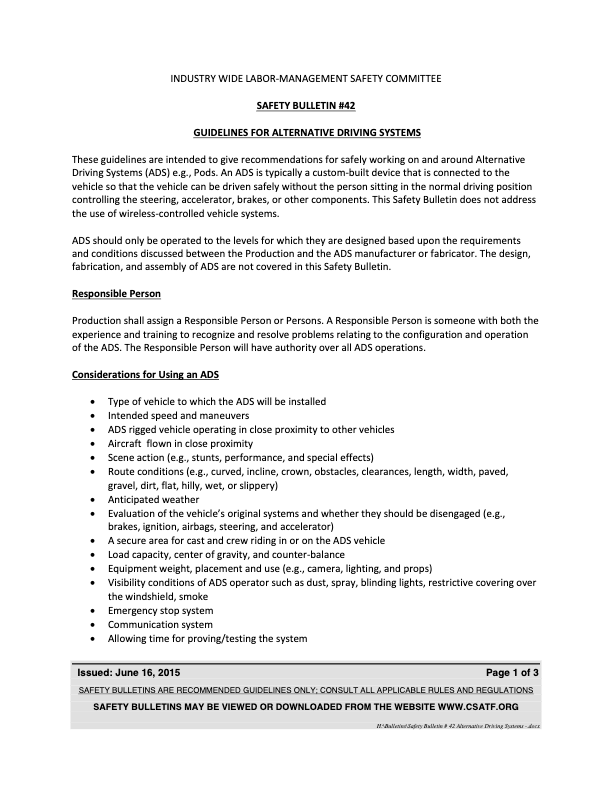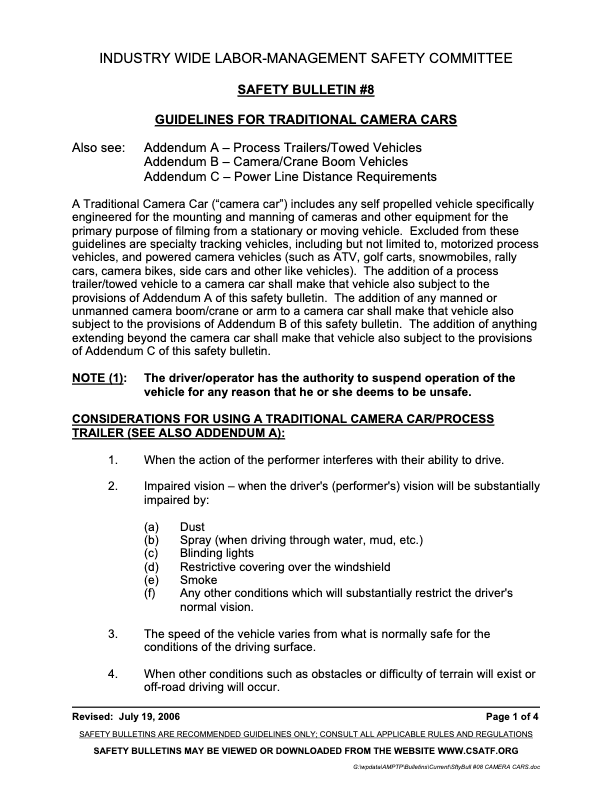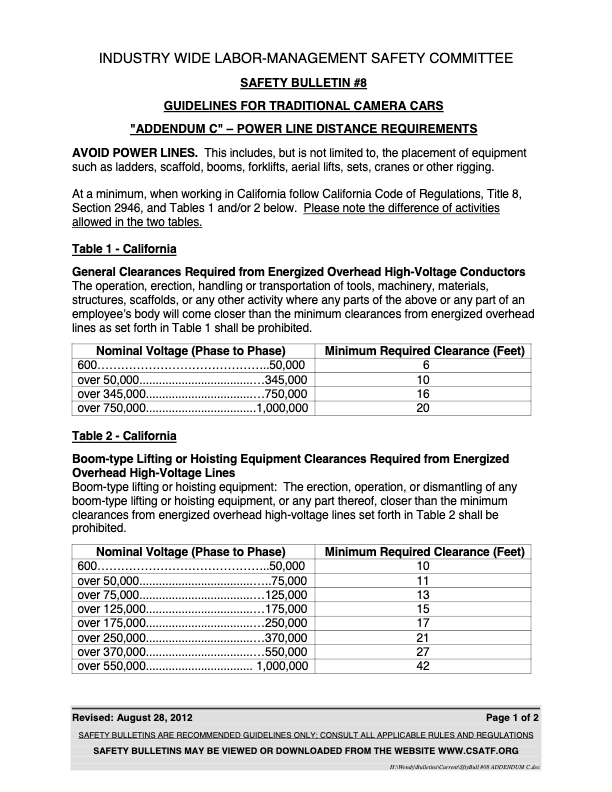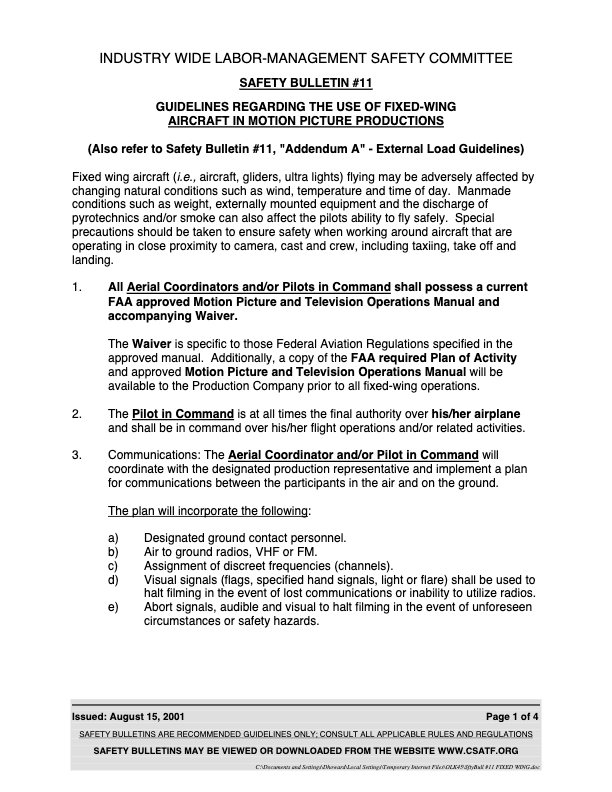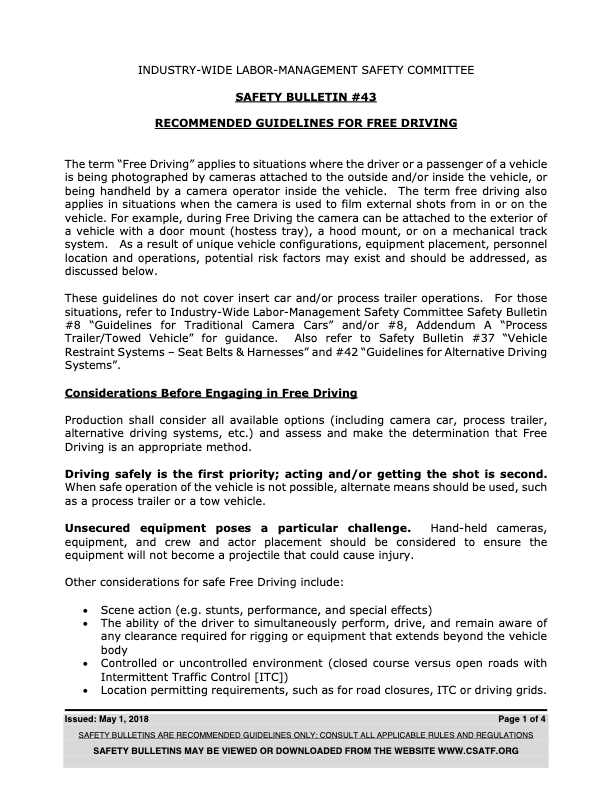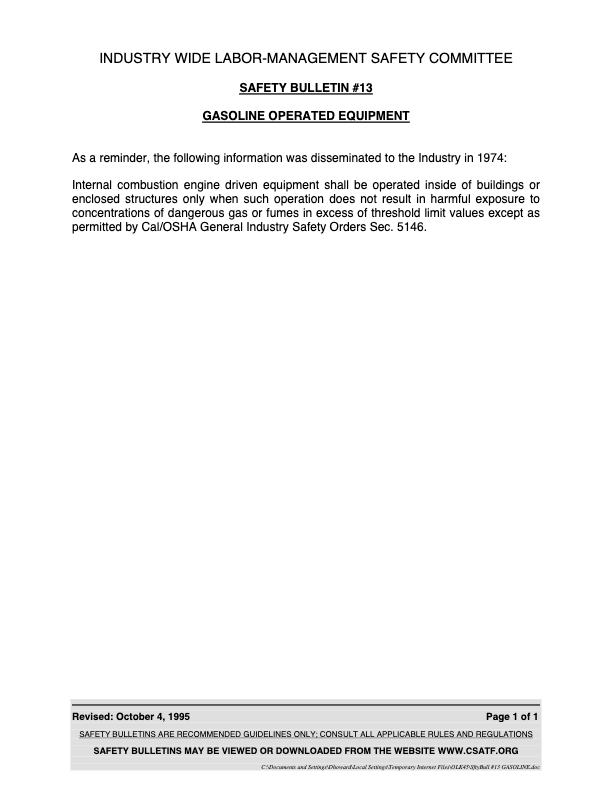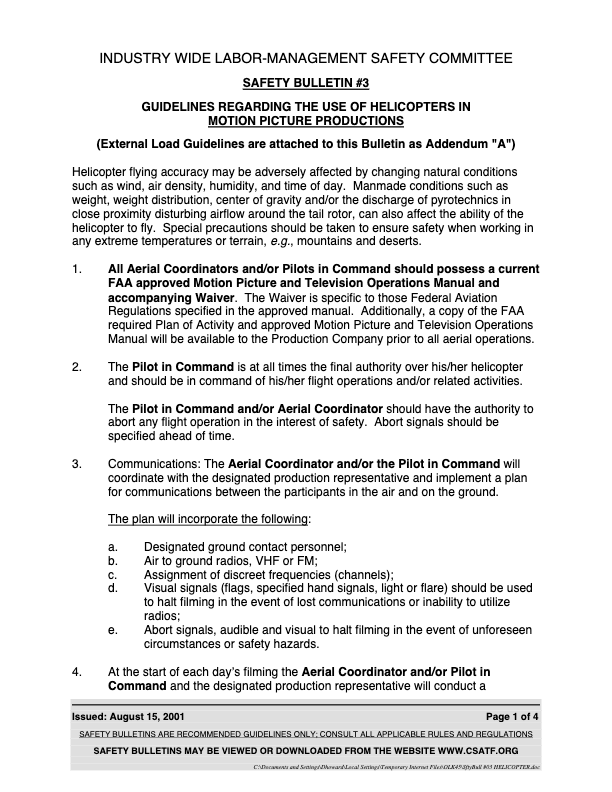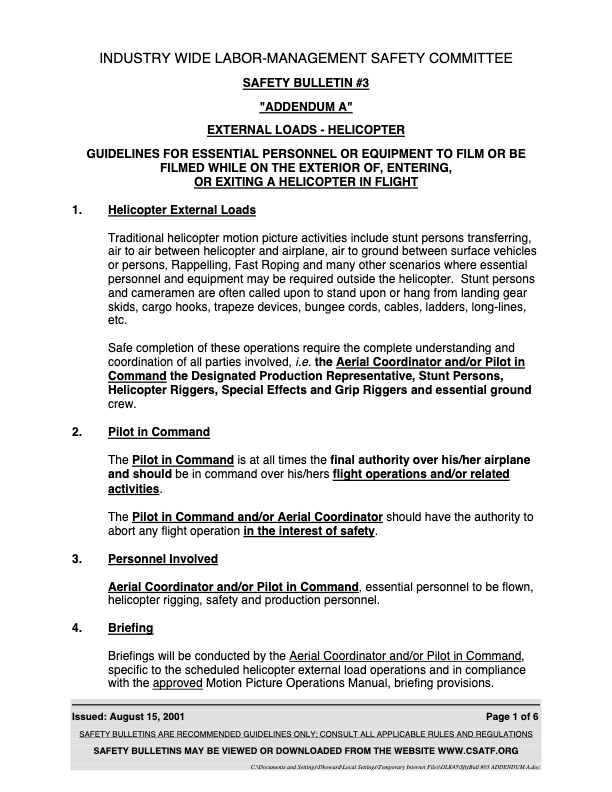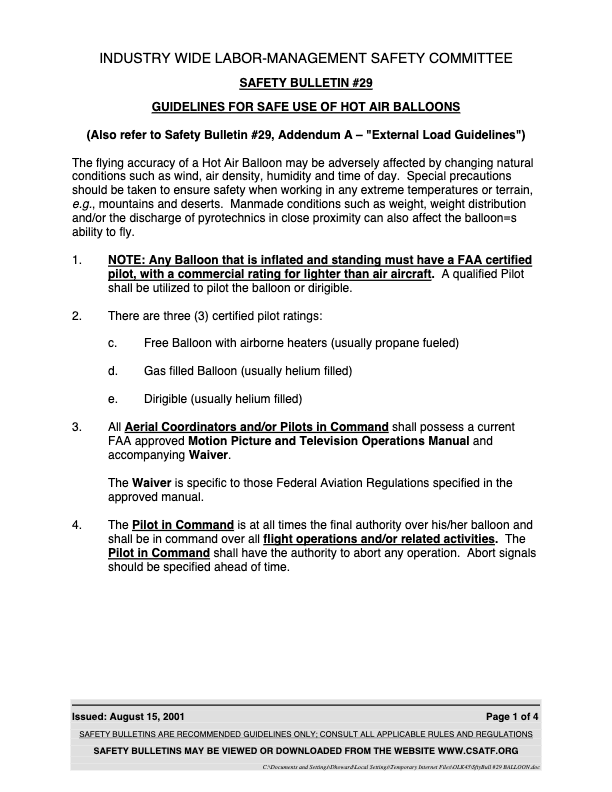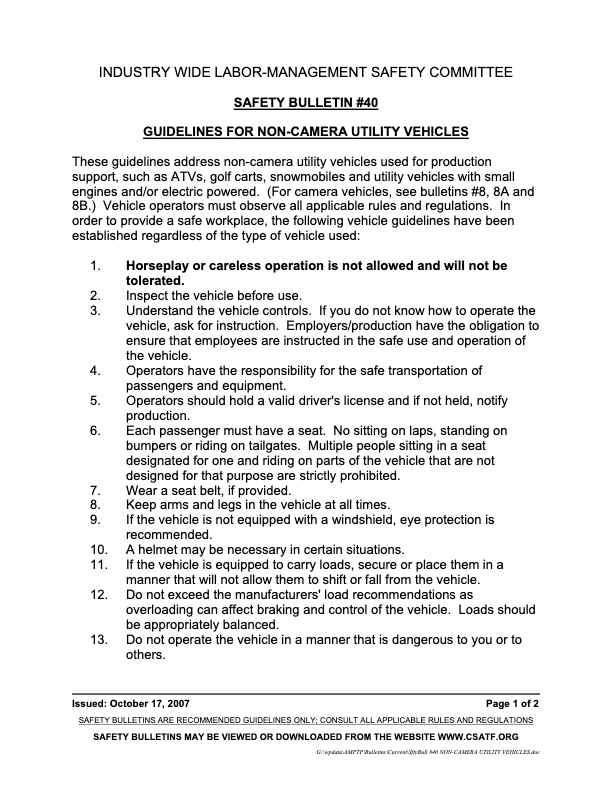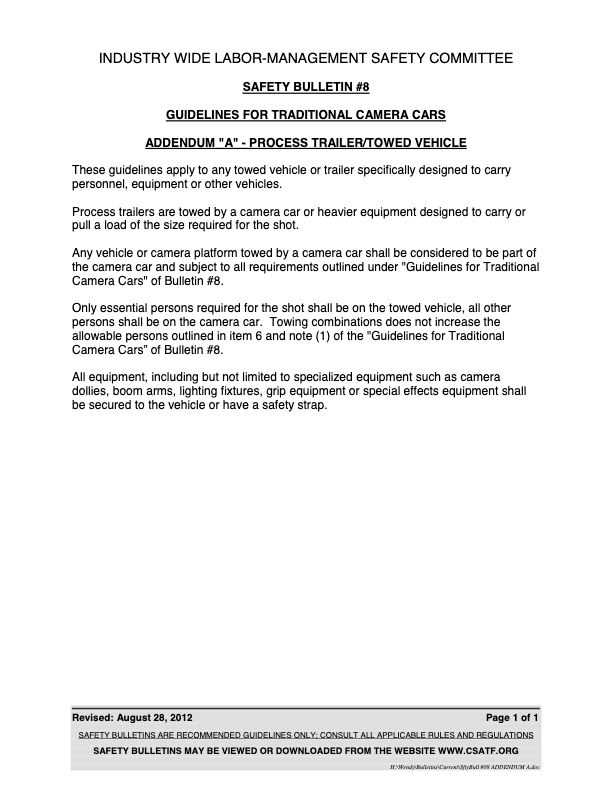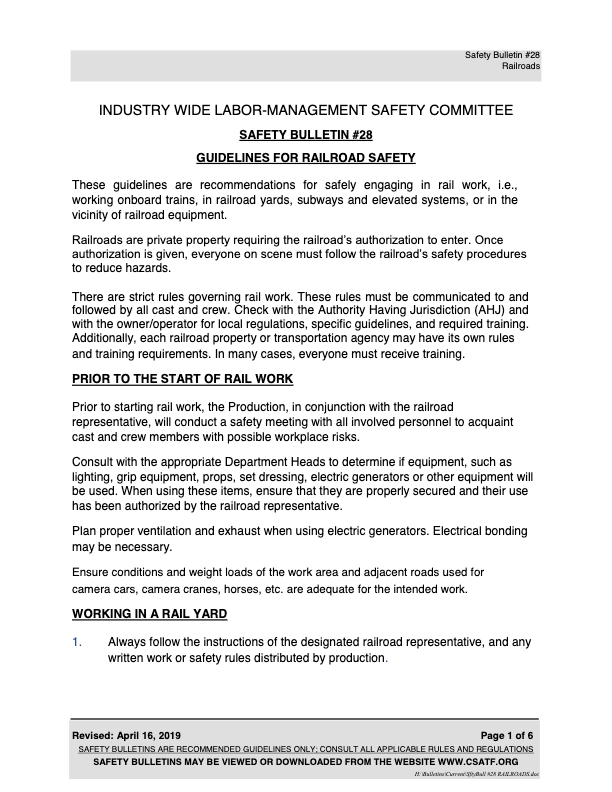Safety Bulletin
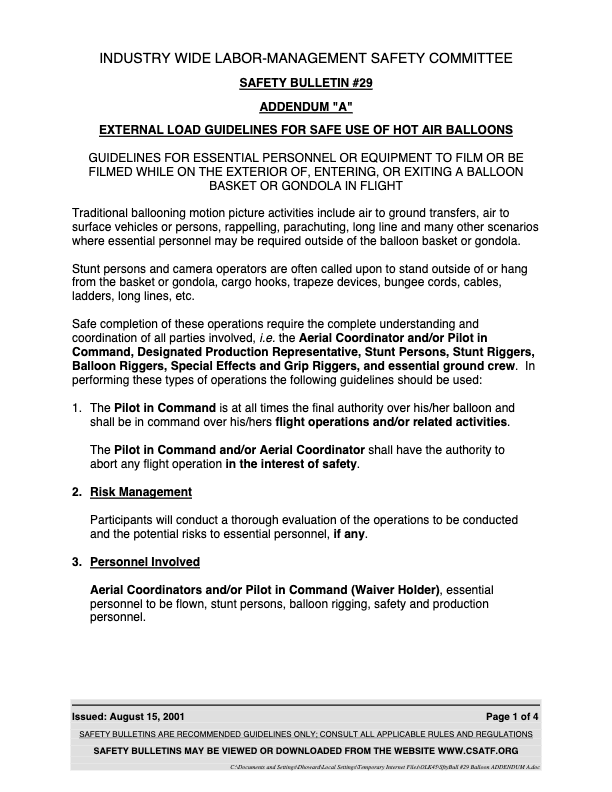
Guidelines
Traditional ballooning motion picture activities include air to ground transfers, air to surface vehicles or persons, rappelling, parachuting, long line and many other scenarios where essential personnel may be required outside of the balloon basket or gondola.
Stunt persons and camera operators are often called upon to stand outside of or hang from the basket or gondola, cargo hooks, trapeze devices, bungee cords, cables, ladders, long lines, etc.
Safe completion of these operations require the complete understanding and coordination of all parties involved, i.e. the Aerial Coordinator and/or Pilot in Command, Designated Production Representative, Stunt Persons, Stunt Riggers, Balloon Riggers, Special Effects and Grip Riggers, and essential ground crew.
- The Pilot in Command is at all times the final authority over his/her balloon and shall be in command over his/hers flight operations and/or related activities. The Pilot in Command and/or Aerial Coordinator shall have the authority to abort any flight operation in the interest of safety.
- Risk Management: Participants will conduct a thorough evaluation of the operations to be conducted and the potential risks to essential personnel, if any.
- Personnel Involved: Aerial Coordinators and/or Pilot in Command (Waiver Holder), essential personnel to be flown, stunt persons, balloon rigging, safety and production personnel.
- Briefing: Briefings will be conducted by the Aerial Coordinator and/or Pilot in Command (Waiver Holder) specific to the scheduled balloon external load operations and in compliance with the approved Motion Picture Operations Manual, briefing provisions.
- Communication: Communication must exist at all times between the Pilot in Command, stunt person(s), camera operator and the essential personnel being flown. This can be accomplished through the use of radios, intercoms or pre-briefed hand signals. Additionally, in the event of lost communications the pilot must be able to maintain visual contact with the stunt person or camera operator. If visual contact cannot be maintained, then a third party who can maintain visual contact will be used. This person may be onboard the balloon, on the ground, or in a chase aircraft.
- Attaching Methods and Devices: Belts, harnesses, cables and safety lines will be attached to existing balloon basket or gondola hard points, cargo tie down points, basket or gondola bridles, or other suitable basket or gondola locations. Attaching devices, cables, carabineers, braided nylon, climbing rope, nylon straps, steel clevises, body harnesses, etc. are normally provided by the motion picture special effects and stunt personnel. All of the above devices have load ratings established by the manufacturer in compliance with various industry and government specifications and established Motion Picture Safety Guidelines. Note: A person will never be attached to a load release device.
- Weight and Balance: Due to the nature of balloon external loads involving essential persons or equipment, diligent review and compliance with the manufacturer’s maximum weight data is required. This can also be accomplished through consultation with pilots having previous experience with similar balloon configuration or through a flight evaluation.
- Pilot Check List:
- Balloon
- Load bearing capacity and method of securing of all attaching devices related to the external load.
- Verification of load bearing capacity and anticipated loads on the basket or gondola attach points to be utilized.
- Accomplish Weight and Balance of the external load, including, if necessary, the possible release or departure of the external load.
- Personnel
- Verify that only essential personnel are onboard the balloon.
- Confirm with essential personnel specific duties and responsibilities.
- Verify all communications and check audio and/or hand signals.
- Review emergency procedures specific to the external load operation with all essential personnel.
- Review any potential risk factor, if any, with the essential personnel.
- No essential personnel may participate in airplane external load operations unless they have read, understood, and agreed to comply with the conditions of the Waiver Holders, Certificate of Waiver and its special provisions, if any.
- Balloon
- Parachutes: If parachutes are to be used, they must be of an FAA approved type and must have been packed and certified within the preceding 120 days. While wearing a parachute the stunt person must not be attached to the balloon. An accidental parachute opening while attached to the balloon could have serious negative effect on the aircraft and parachutist.
- Rappelling:
- Pilot Qualifications:
- Qualifications on the basis of previous experience and safety record, or an actual light, demonstrating the pilot’s knowledge and skill regarding rappelling, and operations.
- Rappeller Qualifications:
- Rappellers and Spotters (Stunt Persons) will be required to demonstrate their ability during required familiarization flights.
- The Waiver Holder and/or Pilot will have the authority to withhold approval of any rappeller or spotter (stunt person).
- Rappelling Special Provisions:
- The Pilot in Command (Waiver Holder) has the authority to cancel or delete any activity or event, if in their opinion, the safety of persons, or property on the ground or in the air is at risk, or if there is a contravention to the provisions of the Motion Picture Waiver.
- Rappelling Equipment:
- Rope size appropriate to the rappel (friction) device being used, will be required for all rappel operations.
- Rope strength for each specific load, a safety factor of 10:1 between the strength of the weakest piece of attaching equipment and the load to be carried will be utilized.
- The absolute minimum tensile strength of any rappel rope will be 5000 lbs., tested to NFPA and/or other regulatory standards.
- Ropes will have a rubber jacket or other appropriate edge protection to give protection on basket or gondola edges when using basket or gondola attach points.
- Carabineers, steel or aluminum must have a minimum tensile strength of 5000 lbs., be of a locking type and be tested to NFPA and/or other regulatory standards.
- Cutting devices, knifes, cable cutters, etc. shall be sufficient to cut any attaching device will be provided to the spotter or safety person(s) for use in an emergency.
- Rappel ropes will have a minimum of two (2) attach points per rope with test strengths greater than or equal to 5000 lbs. per rappeller.
- Pilot Qualifications:

